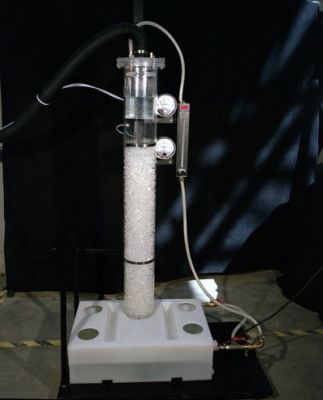SunShot Initiative supporting CSP thermal storage university research with $10M
 Earlier this week the Department of Energy’s (DOE’s) SunShot Initiative announced a new round of funding for university level research into concentrating solar power (CSP) heat transfer technologies. The initiative awarded $5 million each over five years to the University of California in Los Angeles and to the University of Arizona.
Earlier this week the Department of Energy’s (DOE’s) SunShot Initiative announced a new round of funding for university level research into concentrating solar power (CSP) heat transfer technologies. The initiative awarded $5 million each over five years to the University of California in Los Angeles and to the University of Arizona.
The universities are researching innovative ways to create heat transfer materials that can operate at higher temperatures of up to 2,350 degrees Fahrenheit. while simultaneously maintaining high levels of performance. “The hotter the operating temperature of the power cycle, the more efficient the conversion of thermal energy to electrical energy will be,” said a DOE spokesperson speaking on background. “The CSP systems that we’re looking at include not only steam turbines, but also supercritical CO2 turbines and air-Brayton turbines, which operate most efficiently at temperatures of approximately 1,200 Fahrenheit and 2,375 Fahrenheit, respectively. Any heat transfer fluid developed to operate at these high temperatures will also be compatible with a steam turbine.”
While most of the research conducted under the SunShot Initiative is primarily applicable to solar, this research into heat transfer fluids could have other uses. “There are many other potential uses for these fluids, as they could be adapted to any application that needs high temperature heat transfer, for example advanced nuclear reactors,” the spokesperson said.
To get to those levels of heat transfer and high heat, University of California is researching liquid metals as potential heat transfer fluids and the University of Arizona is working with researchers from Arizona State University and Georgia Tech to develop and demonstrate new, molten salt-based, fluids as possible alternatives to other heat transfer fluids, according to DOE.
The higher temperatures may require specialized materials. “At 1,200 Fahrenheit, it is likely that the containment for the heat transfer fluid will be able to be made out of high-nickel content alloys. At temperatures much above 1200 Fahrenheit, it may be necessary to use more specialized containment materials,” the spokesperson said. Already research is being conducted into such specialized containment materials. The National Renewable Energy Laboratory and Savannah River National Laboratory are researching existing specialized containment materials, such as refractory metal or ceramic coating lined stainless steel or nickel alloys, and if they can’t stand up to such materials at those temperatures, may develop new materials.



